Lately, I have not been writing many stories at all. My regular readers will have seen a regular weekly posting coming up, but it is usually based on a recipe rather than a story. It's not that I haven't run out of ideas; in fact, it's quite the opposite - I am full of ideas for (what I consider) good stories. But these days, my time is limited, constrained by family and work duties. Instead of writing, I'm doing a lot more reading. A good friend presented me with a set of books that I would never have chosen to seek out and read, had the selection of bedtime reading material been left up to me. Dark mysteries filled with violent sex acts have never enticed me. But I found the first book in the late Stieg Larsson's trilogy about the intertwined lives of a series of dysfunctional people so compelling that I read every word of every page, which came close to 600.

A classic of Swedish cuisine, provided by Wikipedia: Swedish meatballs are a well-known dish among international culinary experts, potatoes and pickles feature prominently in the food of the characters in The Girl with the Dragon Tattoo , and berry condiments (in this case, the Nordic specialty, lingonberry) were mentioned during more formal dining experiences.
, and berry condiments (in this case, the Nordic specialty, lingonberry) were mentioned during more formal dining experiences.
Mikael Blomkvist is divorced, has a daughter who he doesn't see very often, lives alone (most of the time) and has no qualms about sleeping with any woman he keeps regular company with (although they seem to be the ones making the first move). His busy life as a high-powered journalist and his desire to keep fit don't allow him much time for mundane tasks such as cooking, so he often goes out for brunch (he's not a morning person), where he'll order sandwiches. When he's home, he buys some basic groceries from the local Konsum and makes his own sandwiches (how original), containing ingredients like pickled herring in mustard sauce with chives and egg. Being an urban dweller, he is used to modern comforts. His year-long stay in a remote northern Swedish village made him realise how difficult rural life can be: butter freezes and doesn't spread easily; cheese slicers suddenly take on a new appeal. But the reader will also understand that Mikael likes to eat good food: when his long-time girlfriend comes to visit him, he cooked lamb cutlets with potatoes in cream sauce; during his long cold spell in a lonely island village, he discovered how much he liked fried sausage with potatoes and beets; and when his daughter came up to see him during a surprise visit, he said: "You should have given me some warning so I could buy some good food or something."
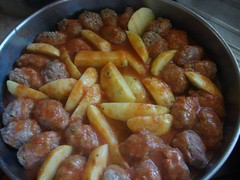

The Greek equivalent to the Swedish meatball dish above would be something like baked meatballs (or bifteki) cooked in tomato sauce. Berries do not fare well in the hot Cretan climate, but creative Cretan cooks are helping Cretan cuisine to constantly evolve by developing recipes using local produce in new ways that often reflect modern food fashions: seasonal pomegranate and nuts in salads have become a staple in local cuisine, and sweet tart salad dressings using balsamic vinegar and honey products are now very popular.
Lisbeth Salander (who is The Girl with the Dragon Tattoo ) eats whatever she can lay her hands on, while her appearance makes most people think she's a chronic anorexic (she must have a good metabolism). She dresses like a punk, never cleans her house, and certainly doesn't cook. Her disconnection to the world around her allows her to become totally absorbed in whatever activity she is involved in. Food is simply something that sustains her. She remembers to eat when her body reminds her that she is hungry, or when someone brings her food. When Mikael first met her, he bought some sandwiches to share with her: she wolfed down a bagel filled with roast beef and another half of a vegetarian one filled with avocado. Although she doesn't cook, she can make sandwiches. She likes them with liver pate and cucumber. She also has some idea of which ingredients pair well with each other: when Mikael became incapacitated, she quickly took over the reins, whipping up a dozen thick rye bread sandwiches filled with cheese, liver sausage and dill pickles.
) eats whatever she can lay her hands on, while her appearance makes most people think she's a chronic anorexic (she must have a good metabolism). She dresses like a punk, never cleans her house, and certainly doesn't cook. Her disconnection to the world around her allows her to become totally absorbed in whatever activity she is involved in. Food is simply something that sustains her. She remembers to eat when her body reminds her that she is hungry, or when someone brings her food. When Mikael first met her, he bought some sandwiches to share with her: she wolfed down a bagel filled with roast beef and another half of a vegetarian one filled with avocado. Although she doesn't cook, she can make sandwiches. She likes them with liver pate and cucumber. She also has some idea of which ingredients pair well with each other: when Mikael became incapacitated, she quickly took over the reins, whipping up a dozen thick rye bread sandwiches filled with cheese, liver sausage and dill pickles.
The classic kiwi sandwich: cheddar cheese, marmite (or vegemite) and lettuce. Although the square-bread triangular-shaped sandwich has gained popularity in the larger urban centres of Greece, it's not really very popular; the only place where you're likely to see a ready-made symmetrical sandwich in Hania, for example, is at the airport. The same sandwich style is more popular toasted. Filled rolls are also very popular, both cold and toasted; fast food outlets make them fresh according to the customers' choices of filling.
Henrik Vanger is a rich old man with a fixation on the 50-year-old disappearance of his niece Harriet. Although he is lucky to have his housekeeper Anna preparing much more enticing food than what Mikael and Lisbeth are eating, he cannot enjoy his meals because he is weak, ill and melancholy. Anna is probably a good cook: roast hare (game meat is popular in Sweden) with currant jelly and potatoes sound very tasty.
Wild hare is the most prized game meat in Hania; hunters are many, but the hare are few, hence it's not often that I get a chance to indulge in (or make) λαγό στιφάδο (lagos stifado - hare stew).
If this book is your first introduction to Swedish culture, then you might be wondering how representative Larsson's views of Swedish cuisine are. Swedish food is often given a cursory reference in global culinary terms, and the collocation 'Swedish restaurant' is not exactly a common one: googling 'Swedish' together with 'restaurant' will tell us that such establishments do exist - but most of the customers don't really know what to expect from such a place, while the Swedes among them will not have been totally enthralled by the meals they were presented with. However, it does share one element with Cretan cuisine: it is constantly evolving, and local chefs are modernising it by showing great respect to the inclusion of local products in new combinations.
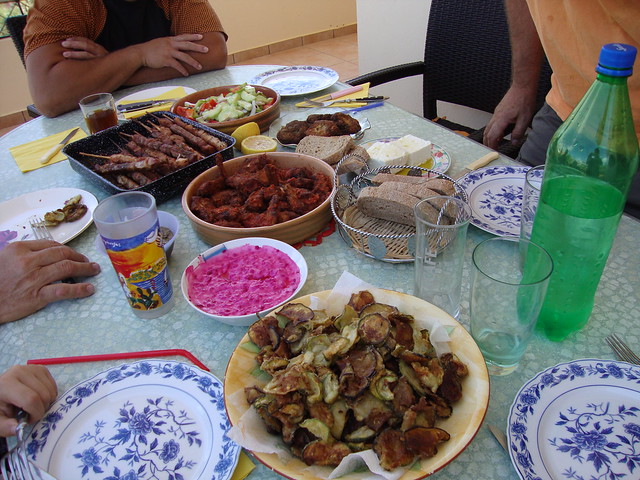
The Swedish smorgasbord sounds similar to the Greek idea of mezedakia - everything is served in small doses, just enough to leave some space for a large range of dishes. When appropriately presented (rather than a mountain of different bit and pieces all piled haphazardly onto one plate like it usually is), the Greek pikilia could probably prove to be the most popular Greek food among the Swedes and other Northern Europeans holidaying in Greece.
Judging from internet sources alone, through the personalities of his characters, Stieg Larsson has unwittingly portrayed Swedish cuisine accurately. Various websites tell us that Swedish cuisine is basically simple, based on meat (and fish) and root vegetables, with fresh produce playing a more prominent role in the southern part of the country. Mikael's simple cooking reflects simplicity: meat, potatoes and some kind of vegetable. This is understandable when the Swedish climate and location are taken into consideration; it follows that a lot of Swedish food in the past will have been prepared from ingredients that had been preserved in some way before refrigeration and easy access to imported food rid the people of dependence on stored food. No wonder sandwiches are popular in this culture. Swedish culinary tradition was once based on people’s need to eat in order to live, as The Girl with the Dragon Tattoo
The Greek frappe is quite a different coffee experience from heating up a coffeepot and making coffee. It can be a very refreshing and relaxing drink in hot weather. Frappe has never really caught on in my life, even after two decades of living in Greece; I still prefer a hot cup of percolated coffee any time of the day.
It's easy to understand what attracts the Swedes to Crete, which is undoubtedly the opposite of what they have access to in their own country. Theirs is a quieter darker colder world compared to the noisy bright hot one that we know in Crete. That's one thing that still can't be exported, not even through globalisation.
*** *** ***
Here's a recipe for meatballs cooked in the Greek fashion that is bound to please our Northern European tourists. The meatballs are baked, making them light in taste and calories, and the tomato sauce gives them an unmistakeable Greek accent. The recipe has been adapted from a book my husband bought because he liked the photos of the finished recipes.For the meatballs, you need:
500g beef mince
500g pork mince (mixing different mince meats is also common practice in most recipes for Swedish meatballs)
2 medium onions, finely minced
4-5 cloves of garlic, finely minced
1 cup of dry breadcrumbs
a few sprigs of mint, finely minced
a wineglass of olive oil
1 tablespoon of tomato paste
1 cup of grated cheese (preferably a strong tasting one like graviera or regato)
sea salt and freshly ground pepper
For the sauce, you need:
2 cups of freshly grated tomato (or the equivalent in tinned tomatoes)
2 tablespoons of tomato paste
a teaspoon of dried oregano or thyme
sea salt and freshly ground pepper
1/2 wineglass olive oil
5 medium potatoes, cleaned and sliced into quarters
This dish can be started the night before cooking it, by mixing all the ingredients for the mince very well, so that all the flavours blend. The next day, before you shape the meatballs, turn on the oven and set it to high heat (200C). Clean the potatoes and slice them into quarters. Place them in the roasting tin (your largest tapsi), season them with salt and pepper, and pour the oil and a cup of water into the tin. Then place them in the oven to start cooking. The potatoes and meatballs will cook together, but the potatoes need to be started before the meatballs because they need more cooking time.
Now shape the seasoned mince into elongated (rather than round) meatballs. After the potatoes have been cooking for half an hour, add the meatballs to the roasting tin. Mix the ingredients for the sauce well, and pour over the potatoes and meatballs. Roast on high heat (200F) for another hour. While cooking, make sure that the sauce does not dry out: if it does not look liquidy, add half to one wineglass of water to make it runny.
This dish is best served with a fresh green fruity salad and some crusty bread to mop up the juices.
*** *** ***
UPDATE: Since I originally wrote this post, I've read the remaining books in the trilogy.The second book contains a tiny snippet of the Greek holiday element, familiar to most Swedes who fly to the south in summer. A policeman is interviewing a lesbian about her relationship with a suspect:
... "Stop screwing around and answer the questions." [he said to her]
"And what was the question?" [the lesbian asked]
Faste closed his eyes for a second and thought about a visit he had paid to the police in Greece when he was on vacation some years earlier. The Greek police, despite all their problems, had one big advantage compared to the Swedish police. If this young woman had taken the same attitude ovr there he would have been able to bend her over and give her three whacks with a baton... (which all goes to show, they're all the same underneath).
Foreign food is eaten throughout the trilogy by various characters when they dine out. The author seems to have chosen different cuisines in a democratic fashion, never mentioning them twice. In the third book, the characters go to a Greek restaurant and order 'calamari with Greek potatoes'. Greek potatoes? What image comes to your mind when you read this? I have no idea what the author meant here, but I assume he meant 'fried' potatoes; hardly a Greek dish...
©All Rights Reserved/Organically cooked. No part of this blog may be reproduced and/or copied by any means without prior consent from Maria Verivaki.
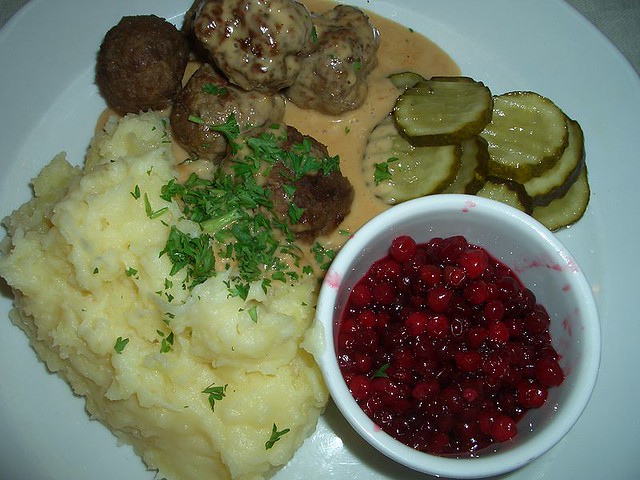
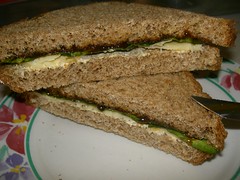
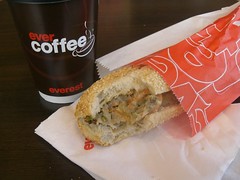



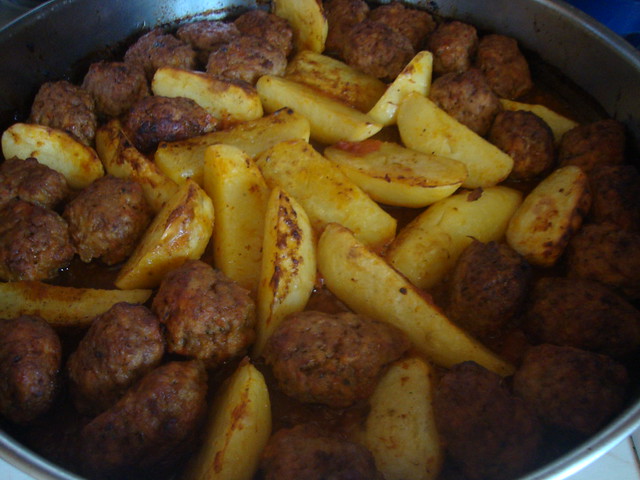
Maria - "Greek potatoes" are lemony, olive-oily potato wedges sprinkled with oregano and baked in the oven. The local taverna in my town, Dimitri's, offers it as a side-dish, and Chris was just saying the other day at my parents' restaurant that he wished they offered it as a side dish too.
ReplyDeletethanks for the explanation - now i know which ones you mean; we do see them at some places in hania, eg cafe-bars, fast-food outlets, mezedopoleia
ReplyDeleteLooks very tastefull Maria mou! Nostimo fagito ;)
ReplyDeleteGoing to try meat balls now..only with mutton. Nice story and thanks for the recipe.
ReplyDeleteI loved all three books of the trilogy, which I finished in January. I wouldn't have picked up a book with such themes either, but Larsson's writing style won me over. Then I saw the American version of the movie, "The Girl with the Dragon Tattoo"-- also well done. And Maria (we must think alike!), I, too, became interested in Swedish cuisine and started Googling for more info. Lisbeth's sandwich with cheese & avocado and some of her other combinations just appealed to me. Of course, I think their diet is too top heavy with all the bread and cheese and I would need more vegetable, fruit, and protein choices to sustain me, but I liked the sound of them and have attempted to make some of them for a quick lunch. I have to admit that I became pretty obsessed with these books when I was reading them and couldn't put them down. And I felt a bit depressed when I finished the third one, knowing there won't be any others coming from Larsson in the future. But I definitely recommend them to my friends.
ReplyDeleteVery interesting post, and the meatballs look great!
ReplyDeleteBeing Scandinavian, I just wanted to comment on this part of the post:
"If we know what and how they like to eat, then we can be better prepared to offer them local dishes cooked/presented in a way that will appeal more to them. "
When I go to Greece, I want to eat real Greek food, not something made more similar to my own food or trying to adapt to "my" taste. One of the best things about going to Greece is the wonderful Greek food, and I hope it will stay that way.